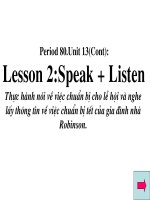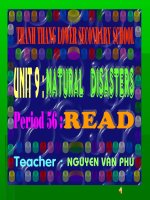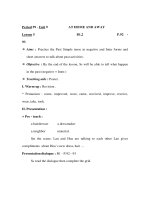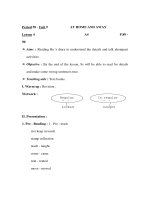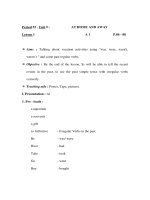- Trang chủ >>
- Sư phạm >>
- Sư phạm địa
lesson plan lesson plan date april 13th2008 period 61 unit 9 cont natural disasters lesson 6 section language focus 234 page 81 82 i objectives by the end of this lesson students will be abl
Bạn đang xem bản rút gọn của tài liệu. Xem và tải ngay bản đầy đủ của tài liệu tại đây (75.76 KB, 2 trang )
<span class='text_page_counter'>(1)</span><div class='page_container' data-page=1>
Lesson plan
<i>Date: April 13th<sub>,2008</sub></i>
<i>Period:61 Unit 9 (Cont) </i>
NATURAL DISASTERS
Lesson 6 Section: LANGUAGE FOCUS 2,3,4( page 81-82 )
I/ Objectives: By the end of this lesson, students will be able to distinguish
between defining Relative clauses and non- defining Relative clauses.
II/ Language contents:
1. Vocabulary: sweep – swept – swept, destroy (v) , extensive (adj),
border (v).
2. Grammar: relative pronouns WHO, THAT and WHICH (view).
III/ Teaching aids: text book, pictures
IV/ Techniques: elicitation, ask and answer, pair work, and group work .
V/ Time: 45 minutes
VI/ Procedures:
Stages/ time Contents Notes
Warm up 5’
Activity 1
5’
Activity 2
* <i>Chatting</i>:
Which provinces is in the north of
Vietnam? Can you read the names.
Students’ answers:
Cao Bang, Lang Son…
<i>I.Pre-teach vocabulary</i>:
- sweep – swept – swept
- destroy (v)
- extensive (adj) = large
- border (v).
<i>*Checking vocabulary : Rub out and</i>
<i>remember</i>
<i>II. Defining Relative clauses and </i>
<i>non- defining Relative clauses</i>
1. The novel which you gave
me on my birthday has been
lost.
2. Vietnam which is in the
Southeast Asia exports rice.
<i>Recognizing non – definingh Relative</i>
Individual work
*Feedback and correction
Teacher introduces the new
vocabulary and gives their
meanings.
Mime
(Translation)
(Synonym)
(Visual)
- Rub out the words one at
a time. Each time you rub
out an English word, point
to the Vietnamese . When
all the English words are
rubbed out , go through the
Vietnamese list and gets
students to call out the
English words
Teacher gives students two
pairs of sentences and asks
them to use relative
pronoun WHO or WHICH
to combine them.
</div>
<span class='text_page_counter'>(2)</span><div class='page_container' data-page=2>
10’
Activity 3
10’
Production
10’
Homework 5’
<i>clauses</i>.
<i>Answer keys</i>:
b. Kangaroos, which come from
Australia have long tails.
c. Ba, who lives in Trang Tien street,
likes playing the guitar.
d. The novel that you gave me on my
birthday has been lost.
e. Neil Armstrong, who first walked
on the moon, lives in the USA.
f. The cvhair that bought yesterday is
broken.
g. Mrs Lien , who sings very well, is
my English teacher.
<i>III. Matching</i>:
* Answer keys:
1-e which
2- g which
3- f which
4- a which
5- c which
6- d which
7- b which
* <i>Writing</i>:
Ex:
A, Vietnam, which is a small country,
exports rice.
B, Kangaroos, which are called
“Chuot tui” in Vietnamese, have long
tails.
……
- Learn the vocabulary by heart
- Do the exercises in the workbook
into your notebook
- write the letter in to your notebook
- Prepare : TEST 45’
- Remarks
* We cannot use “that” in a
non – defining relative
clauses.
* In a non – defining
relative clauses We cannot
leave out WHO or WHICH
T asks students to do
exercise 3 on page 82 .
T asks students to
underline the Relative
clauses.
T asks students to work in
pairs
T asks students to do
exercise 2 on page 81-82
T asks students to match A
with B use the relative
pronouns
*Feedback and correction
Individual work
</div>
<!--links-->



